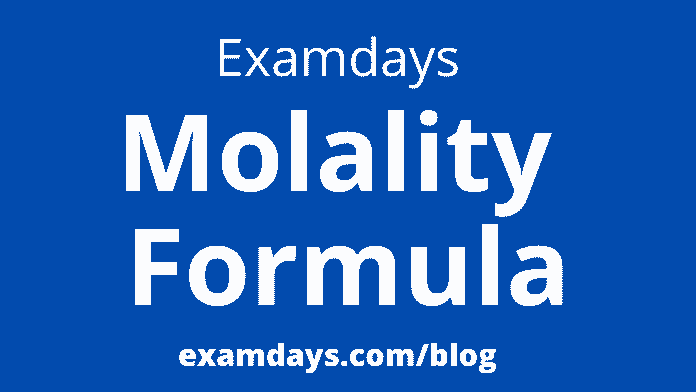
A molality is a unit of measurement used to calculate the amount of dissolved substance in a solution. Molality differs from other solution units, such as mass percent, volume percent, parts per million, and molarity. To further explain the definition of molality, we must answer the question: What is the molality of a solution? To solve this, we must first define what a solution is.?
A solution is a homogeneous (e.g., physically and chemically uniform) mixture in which one substance is dissolved in another. The dissolved substance is the solvent, and the dissolved substance is the solvent. For example, dissolving sugar in water produces a solution in which sugar is the solute and water is the solute. Scientists calculate the amount of solute in a solution using units of concentration (e.g., mass percent, molarity, morality).
Molality Formula
The molality is defined as the amount of solute (in moles) per mass (in kilograms) of solvent. For example, seawater contains 0.47 moles of dissolved sodium per kilogram of water. So we can describe seawater as a 0.47 molal solution of sodium.
A mole is an international standard for specifying the amount of a substance and is used when counting the number of submicroscopic entities such as atoms and molecules. Chemists use molar units when working with chemical reactions because they provide a standardized basis for calculating the number of particles (atoms or molecules) involved in a given reaction. One mole is equal to6.02x1023entities (e.g., atoms or molecules). This value is called Avogadro’s number in honor of the pioneering physicist who discovered some of the fundamental laws of chemistry. When dealing with chemical reactions in solutions, chemists often use mole-based units such as molarity and molality.
Molality differs from other standard concentration units in that it specifies the amount of solute per volume of solution (rather than the amount of solute). For example, a mass percent is a unit of concentration that measures the amount of a solution in grams of solute (e.g., dissolved sugar) in 100 grams of solution (e.g., a mass of water + dissolved sugar).
Molality Formula in Grams
Mass Percent = ( mass of solute / mass of solution ) × 100%
Other common concentration units used are, for example, parts per million and parts per billion in water quality reports. These units help quantify small solute concentrations, such as the amounts of dissolved salts and metals in tap water. Parts per million is defined as one part solute in a million parts solution, and parts per billion are one part solute in a billion parts solution. The most common way to express these two units is the mass of the solution and the volume of the solution.
Molality Formula Class 12
Parts per million = ( milligrams of solute / liters of solution )
Parts per billion = ( micrograms of solute / liters of solution )
The concentration unit molarity is similar to molality because it is a mole-based unit. However, molality is defined based on the solute’s mass rather than the solute’s mass. The formula for molal concentration units is:
Molarity(M) = ( moles of solute / liters of solution ) = ( mole / L )
One mole of sugar solution contains precisely 1 mole of dissolved sugar per 1 kilogram of water. Molality is usually abbreviated using a lowercase “m” while molality is indicated using an uppercase “M”. Molarity is a simple and convenient way to calculate solution concentrations; However, it has a significant limitation.
Molarity depends on temperature because the volume of a solution changes when heated or cooled. For example, we dissolve 0.5 moles of sodium chloride salt in 1 liter of water at 1 degree Celsius. It forms a solution with a salt concentration of 0.5 molars, similar to seawater’s salt concentration. The solute (salt) concentration can also be calculated as 0.5 molal because, at 1 degree Celsius, 1 liter of water is approximately 1 kilogram of water.
If the temperature of our solution rises to 99 degrees Celsius, its volume will increase accordingly, thus changing the molar concentration. The table below shows that a 0.50 molar solution at 1 degree Celsius becomes a 0.48 molar solution at 99 degrees. But note that the molality of a solute does not change with temperature because the mass of the solute (in kilograms of solute) remains constant as the temperature changes.
How to Calculate Molality?
As shown in the section above, we can calculate the molarity of a solution as long as we know the solute, concentration, density, and volume. The method of these calculations always consists of three main steps, but they may vary slightly in application depending on the units in which this information is given. Troubleshooting Steps:
Step 1. Find the mass (grams) or (kilograms) of the solvent.
Step 2. Determine the moles of solute.
Step 3. Calculate molality using the molality concentration formula.
Conclusion:
Molality is defined as no. of moles of solute per kilogram of solvent. A molality is a unit of measurement used to calculate the amount of a substance dissolved in a solution. Molality differs from other solution units, such as mass percent, volume percent, parts per million, and molarity.
Join Examdays Telegram
For more details about the Telegram Group, Click the Join Telegram below button.
In case of any doubt regarding Telegram, you can mail us at [email protected].




